-
Countries
-
Data and Analysis
-
Special Focus
-
Crisis Responses
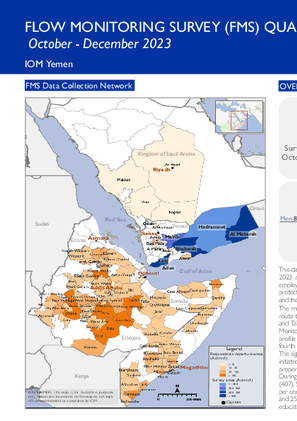
Contact
DTM Yemen, DTMYemen@iom.int
Language
English
Location
Yemen
Period Covered
Oct 01 2023
Dec 31 2023
Activity
- Survey
- Flow Monitoring Survey
- Flow Monitoring
This dashboard compiles flow monitoring survey (FMS) data collected in Yemen between October and December 2023 and provides an analysis of migrants’ demographic and socio-economic profiles, including education and employment backgrounds, reasons for leaving their country of origin or habitual residence, future travel intentions, protection and challenges faced during the journey. Also included are migrants’ highest level of education achieved and their labour status prior to moving.
The migration routes in the southern part of Yemen are categorized along two main routes: the south-eastern route towards Shabwah, Hadramawt, and Al Maharah governorates and the north-eastern route towards Lahj and Ta’iz governorates. Both routes are travelled by a large number of migrants each year. Through the Flow Monitoring Registry tool, which focuses on total numbers of migrants (as opposed to the more detailed migrant profile established through the FMS).
DTM recorded 4,853 migrants entered Yemen through the south in the fourth quarter of 2023. This figure represents a significant decrease (-68%) compared to the previous quarter. The significant and steady decrease observed since August is likely attributed to the ongoing joint military campaign initiated to combat smuggling and secure the coastline of Lahj, a well-known governorate for receiving the largest proportion of migrants. The campaign involved deploying troops, conducting raids, and establishing checkpoints.
During the fourth quarter of 2023, a total of 2,897 surveys were conducted. In Aden (435), Lahj (636), Ma’rib (407), Shabwah (609), Hadramawt (174) and Al Maharah (636). The overall number of surveys increased by seven per cent over the previous quarter. The majority of respondents were young male adults between the age of 17 and 25 (75%) searching for economic opportunities (97%), most of whom were single (94%), attained primary education or less (61%), were currently unemployed (95%) and departed from rural areas (67%).
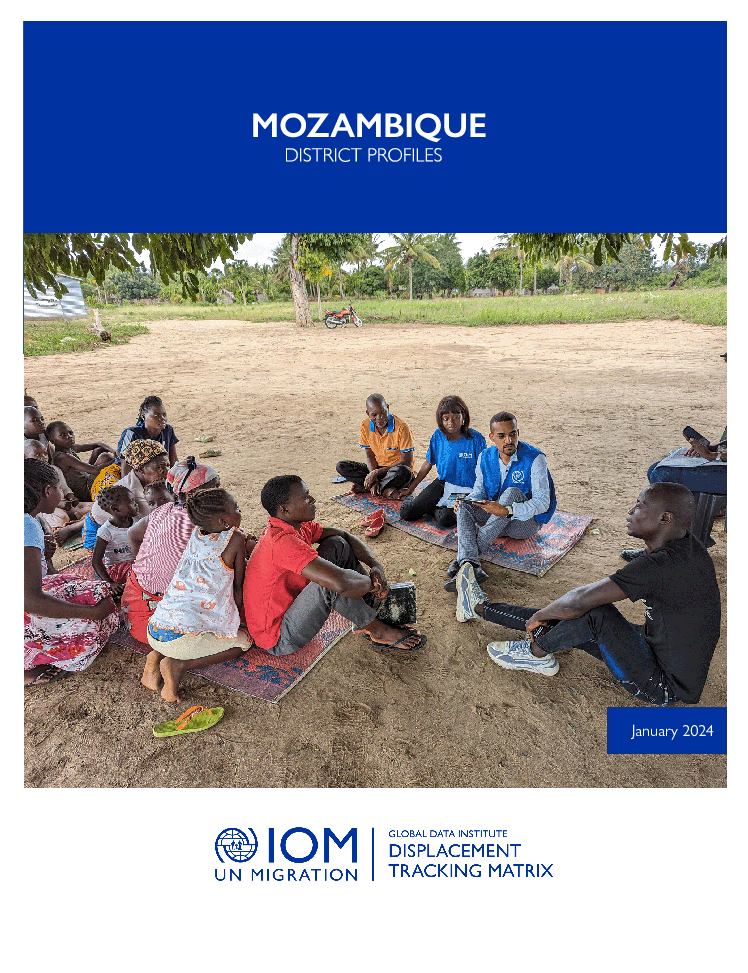
Contact
DTM Mozambique, DTMMozambique@iom.int
Language
English
Location
Mozambique
Period Covered
Dec 05 2023
Dec 29 2023
Activity
- Mobility Tracking
This district profile is part of our comprehensive analysis in the 20th round of Mobility Tracking Assessments. This one-pager per district succinctly summarizes the situation of IDPs in a specific district, focusing on IDPs population trends, demographics, origins, living conditions, and their most pressing needs.
Contact
dtmlebanon@iom.int
Location
Lebanon
Activity
- Mobility Tracking
- Baseline Assessment
Period Covered
Oct 10 2023 -Feb 13 2024
Since October 8 there has been an increase in cross-border incidents between Israel and Lebanon, resulting in the displacement of people both within the South and elsewhere within the country. Since October 10, the Displacement Tracking Matrix (DTM) has been conducting the daily monitoring of population movements. The objective of the exercise is to inform preparedness and response planning.
Population Groups
IDPs
Survey Methodology
Unit of Analysis Or Observation
Admin Area 2
Admin Area 3
Type of Survey or Assessment
Key Informant
Keywords
Geographical Scope Full Coverage
Administrative boundaries with available data
The current dataset covers the following administrative boundaries

Contact
DTM Nigeria, iomnigeriadtm@iom.int
Language
English
Location
Nigeria
Period Covered
Feb 05 2024
Feb 11 2024
Activity
- Mobility Tracking
- Event Tracking
Between 05 and 11 February 2024, a total of 3,260 new arrivals were recorded at locations in Adamawa and Borno states. The new arrivals were recorded at locations in Askira/Uba, Bama, Gwoza, Kaga, Monguno and Ngala Local Government Areas (LGAs) of the most conflict-affected Borno State, in Fufore, Girei, Gombi, Guyuk, Hong, Lamurde, Madagali, Maiha, Michika, Mubi North, Mubi South, Numan, Song, Yola North and Yola South LGAs of Adamawa State and Busari, Damaturu, Nguru, Potiskum and Tarmuwa LGAs of Yobe State.
ETT assessments identified the following movement triggers: fear of attack (1,490 individuals or 46%), poor living conditions (549 individuals or 17%), family re-unification (442 individuals or 14%), improved security (278 individuals or 8%), seasonal farming (183 individuals or 6%), access to humanitarian support (180 individuals or 5%), military operations (101 individuals or 3%) and attacks (37 individuals or 1%).

Contact
DTM Nigeria, iomnigeriadtm@iom.int
Language
English
Location
Nigeria
Period Covered
Jan 29 2024
Feb 04 2024
Activity
- Mobility Tracking
- Event Tracking
Between 29 January and 04 February 2024, a total of 1,578 new arrivals were recorded at locations in Adamawa and Borno states. The new arrivals were recorded at locations in Askira/Uba, Bama, Biu, Chibok, Damboa, Dikwa, Gubio, Gwoza, Kaga, Konduga, Kwaya/Kusar, Monguno and Ngala Local Government Areas (LGAs) of the most conflict-affected Borno State and in Fufore, Girei, Gombi, Guyuk, Hong, Lamurde, Madagali, Maiha, Mayo-Belwa, Michika, Mubi North, Numan, Song, Yola North and Yola South LGAs of Adamawa State.
ETT assessments identified the following movement triggers: poor living conditions (264 individuals or 17%), seasonal farming (253 individuals or 16%), military operations (239 individuals or 15%), family re-unification (229 individuals or 14%), access to humanitarian support (225 individuals or 14%), improved security (182 individuals or 12%), fear of attack (154 individuals or 10%) and attacks (32 individuals or 2%).

Contact
DTM Nigeria, iomnigeriadtm@iom.int
Language
English
Location
Nigeria
Period Covered
Jan 22 2024
Jan 28 2024
Activity
- Mobility Tracking
- Event Tracking
Between 22 and 28 January 2024, a total of 2,198 new arrivals were recorded at locations in Adamawa and Borno states. The new arrivals were recorded at locations in Askira/Uba, Bama, Damboa, Dikwa, Gubio, Gwoza, Hawul, Kaga, Kala/Balge, Mafa, Monguno and Ngala Local Government Areas (LGAs) of the most conflict-affected Borno State and in Fufore, Ganye, Girei, Gombi, Guyuk, Hong, Lamurde, Madagali, Maiha, Mayo-Belwa, Michika, Mubi North, Mubi South, Numan, Song, Yola North and Yola South LGAs of Adamawa State.
ETT assessments identified the following movement triggers: family re-unification (532 individuals or 24%), poor living conditions (517 individuals or 24%), access to humanitarian support (321 individuals or 15%), improved security (310 individuals or 14%), fear of attack (214 individuals or 10%), seasonal farming (182 individuals or 8%), military operations (113 individuals or 5%) and attacks (7 individuals or <1%).
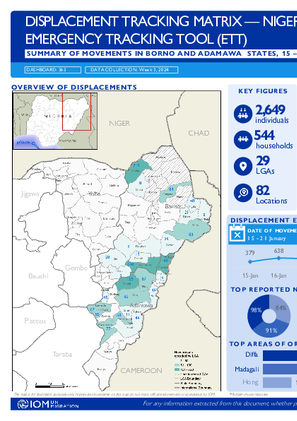
Contact
DTM Nigeria, iomnigeriadtm@iom.int
Language
English
Location
Nigeria
Period Covered
Jan 15 2024
Jan 21 2024
Activity
- Mobility Tracking
- Event Tracking
Between 15 and 21 January 2024, a total of 2,649 new arrivals were recorded at locations in Adamawa and Borno states. The new arrivals were recorded at locations in Askira/Uba, Bama, Biu, Damboa, Dikwa, Gubio, Gwoza, Hawul, Kala/Balge, Mobbar, Monguno and Ngala Local Government Areas (LGAs) of the most conflict-affected Borno State and in Fufore, Girei, Gombi, Guyuk, Hong, Lamurde, Madagali, Maiha, Mayo-Belwa, Michika, Mubi North, Numan, Song, Yola North and Yola South LGAs of Adamawa State.
ETT assessments identified the following movement triggers: poor living conditions (995 individuals or 38%), family re-unification (408 individuals or 15%), fear of attack (399 individuals or 15%), improved security (310 individuals or 12%), access to humanitarian support (260 individuals or 10%), seasonal farming (161 individuals or 6%), military operations (83 individuals or 3%) attacks (33 individuals or 1%).
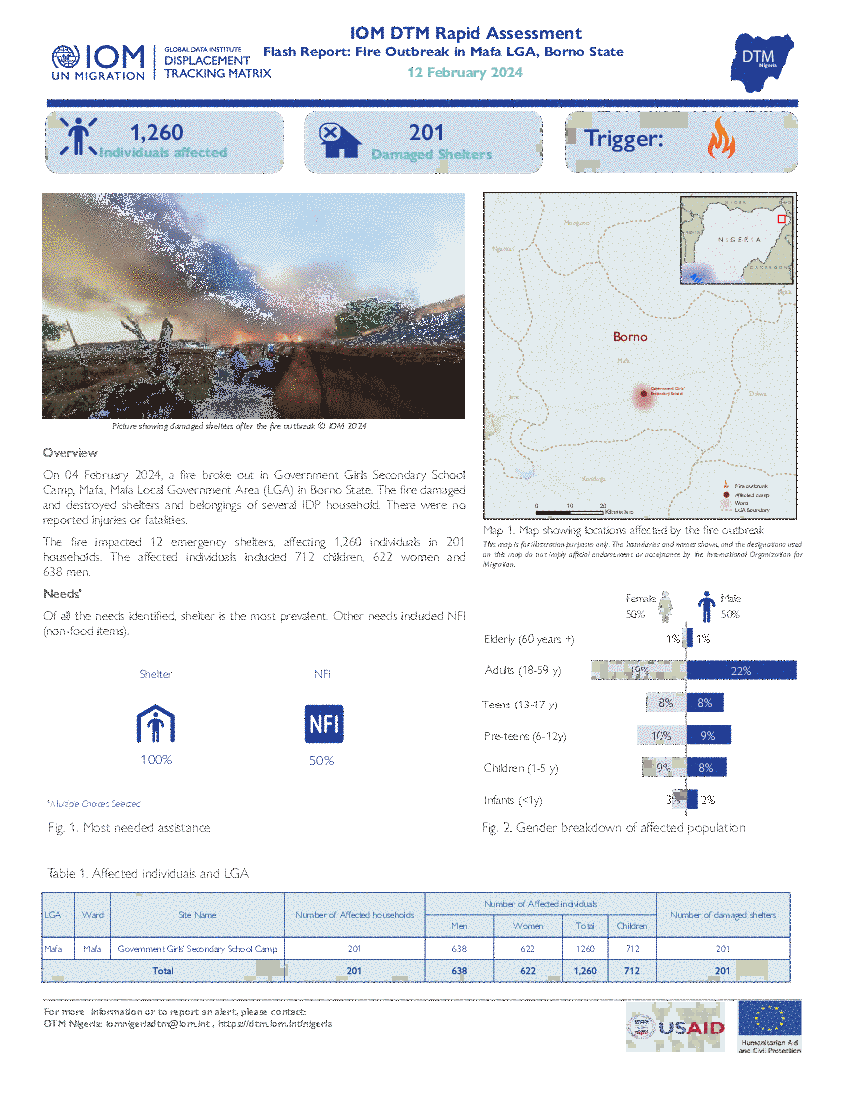
Contact
DTM Nigeria, iomnigeriadtm@iom.int
Language
English
Location
Nigeria
Snapshot Date
Feb 04 2024
Activity
- Mobility Tracking
- Event Tracking
On 04 February 2024, a fire broke out in Government Girls Secondary School Camp, Mafa, Mafa Local Government Area (LGA) in Borno State. The fire damaged and destroyed shelters and belongings of several IDP household. There were no reported injuries or fatalities.
The fire impacted 12 emergency shelters, affecting 1,260 individuals in 201 households. The affected individuals included 712 children, 622 women and 638 men.

Contact
DTM Nigeria, iomnigeriadtm@iom.int
Language
English
Location
Nigeria
Period Covered
Feb 06 2024
Feb 07 2024
Activity
- Mobility Tracking
- Event Tracking
On 06 and 07 February 2024, fires broke out in GSSSS camp Monguno, and Mashamari Kuluye camp of Konduga Local Government Area (LGA) of Borno State, which destroyed the shelters and possessions of many Internally Displaced Persons (IDPs). Many personal items have been lost in the fire, including food items and non-food items. Three fatalities were reported after the incident.
The fire destroyed 58 self-made/makeshift shelters affecting 391 individuals in 58 households. The affected individuals included 223 children, 88 women and 80 men.
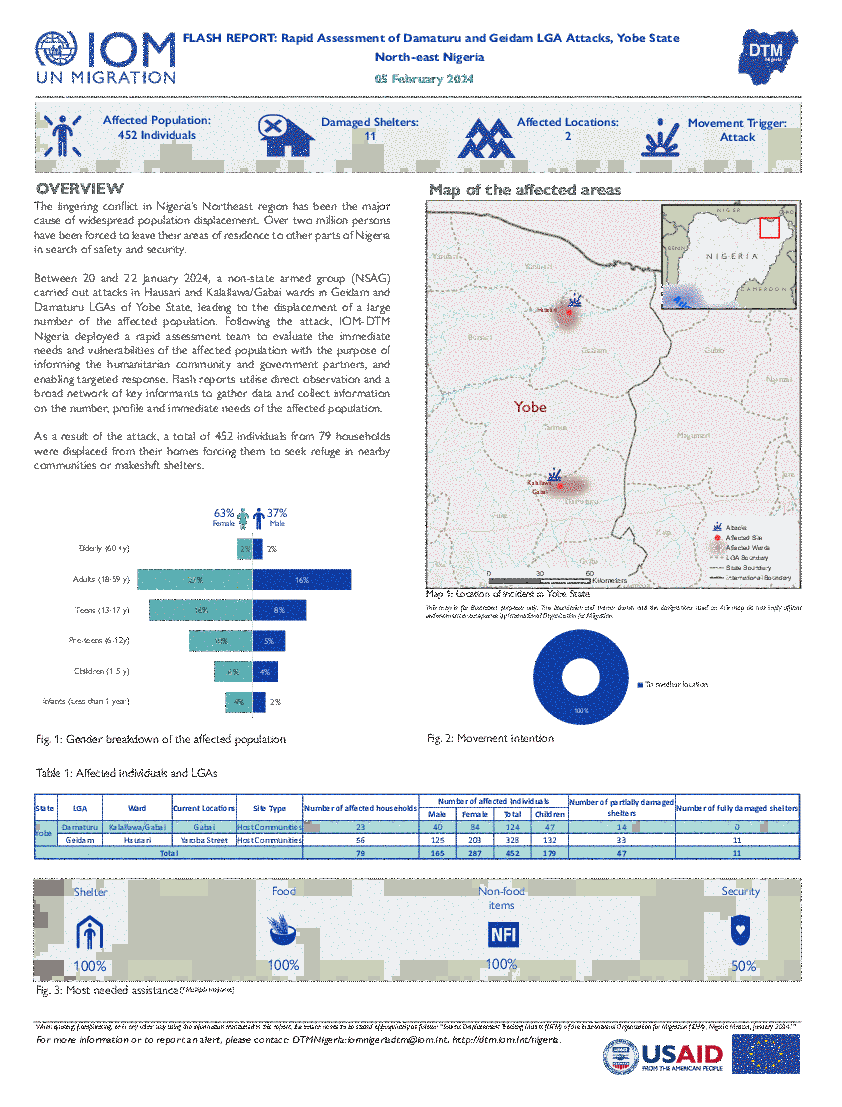
Contact
DTM Nigeria, iomnigeriadtm@iom.int
Language
English
Location
Nigeria
Period Covered
Jan 20 2024
Jan 22 2024
Activity
- Mobility Tracking
- Event Tracking
Between 20 and 22 January 2024, a non-state armed group (NSAG) carried out attacks in Hausari and Kalallawa/Gabai wards in Geidam and Damaturu LGAs of Yobe State, leading to the displacement of a large number of the affected population.
As a result of the attack, a total of 452 individuals from 79 households were displaced from their homes forcing them to seek refuge in nearby communities or makeshift shelters.